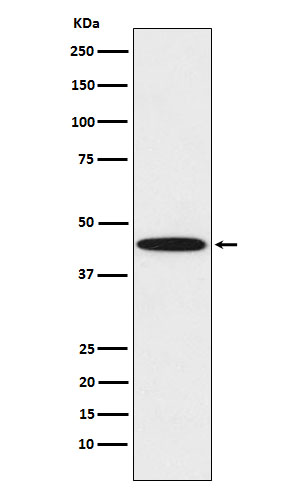
| WB | 1/1000-1/2000 | Human,Mouse,Rat |
| IF | 咨询技术 | Human,Mouse,Rat |
| IHC | IHC:1/100-1/200;IHF:1/50-1/200 | Human,Mouse,Rat |
| ICC | 1/50-1/200 | Human,Mouse,Rat |
| FCM | 1/20-1/100 | Human,Mouse,Rat |
| Elisa | 咨询技术 | Human,Mouse,Rat |
| Aliases | DDB p48 subunit; Ddb2; DDBb; UV-DDB 2;;DNA damage binding protein 2 |
| WB Predicted band size | Calculated MW: 48 kDa ; Observed MW: 45 kDa |
| Host/Isotype | Rabbit IgG |
| Antibody Type | Primary antibody |
| Storage | Store at 4°C short term. Aliquot and store at -20°C long term. Avoid freeze/thaw cycles. |
| Species Reactivity | Human |
| Immunogen | A synthesized peptide derived from human DNA damage binding protein 2 |
| Formulation | Purified antibody in PBS with 0.05% sodium azide,0.05% BSA and 50% glycerol. |
+ +
以下是关于DDB2抗体的3篇文献摘要信息:
---
1. **文献名称**:*DDB2 regulates DNA repair through the PCNA ubiquitination pathway in response to UV radiation*
**作者**:El-Mahdy, M. A., et al.
**摘要**:研究揭示了DDB2在紫外线(UV)诱导的DNA损伤修复中的作用,通过调控PCNA泛素化促进损伤修复。实验中利用特异性DDB2抗体进行Western blot和免疫荧光分析,证明DDB2缺失会抑制损伤位点的修复蛋白招募。
---
2. **文献名称**:*CRL4DDB2 ubiquitin ligase interacts with histone deacetylases to suppress transcription in response to DNA damage*
**作者**:Puumalainen, M. R., et al.
**摘要**:该研究探讨DDB2作为CRL4复合物亚基,在DNA损伤后通过组蛋白去乙酰化抑制转录的机制。通过DDB2抗体进行免疫共沉淀实验,发现其与HDAC1/2的相互作用,揭示了表观遗传调控在修复中的重要性。
---
3. **文献名称**:*DDB2 as a prognostic marker in cutaneous squamous cell carcinoma*
**作者**:Matsuda, A., et al.
**摘要**:研究评估了DDB2在皮肤鳞状细胞癌中的表达及其预后意义。利用DDB2抗体对患者组织进行免疫组化分析,发现低表达DDB2与肿瘤侵袭性增强和患者生存率下降显著相关,提示其作为潜在生物标志物的价值。
---
这些文献涵盖了DDB2在DNA修复机制、表观调控及临床预后中的应用,均通过特异性抗体进行关键实验验证。
The DDB2 antibody is a crucial tool for studying the DNA damage-binding protein 2 (DDB2), a component of the ubiquitin-proteasome system involved in nucleotide excision repair (NER). DDB2 forms a heterodimer with DDB1 to create the UV-DDB complex, which recognizes UV-induced DNA lesions such as cyclobutane pyrimidine dimers (CPDs) and 6-4 photoproducts (6-4PPs). This complex initiates NER by recruiting downstream repair factors, including XPC, and facilitates lesion ubiquitination to signal for repair. Mutations in DDB2 are linked to xeroderma pigmentosum complementation group E (XP-E), a genetic disorder characterized by impaired DNA repair and heightened UV sensitivity.
DDB2 antibodies are widely used in molecular biology to detect and quantify DDB2 expression via techniques like Western blotting, immunohistochemistry, and immunofluorescence. They also enable functional studies, such as co-immunoprecipitation to explore DDB2-protein interactions, or chromatin immunoprecipitation (ChIP) to map its binding sites on damaged DNA. Researchers employ these antibodies to investigate DDB2's role in DNA damage response, cancer progression (where dysregulation may affect genomic stability), and cellular stress pathways. Validating antibody specificity—using knockout cell lines or siRNA-mediated knockdown—is critical to avoid cross-reactivity with homologous proteins. Both monoclonal and polyclonal variants exist, offering flexibility for diverse experimental needs.
×